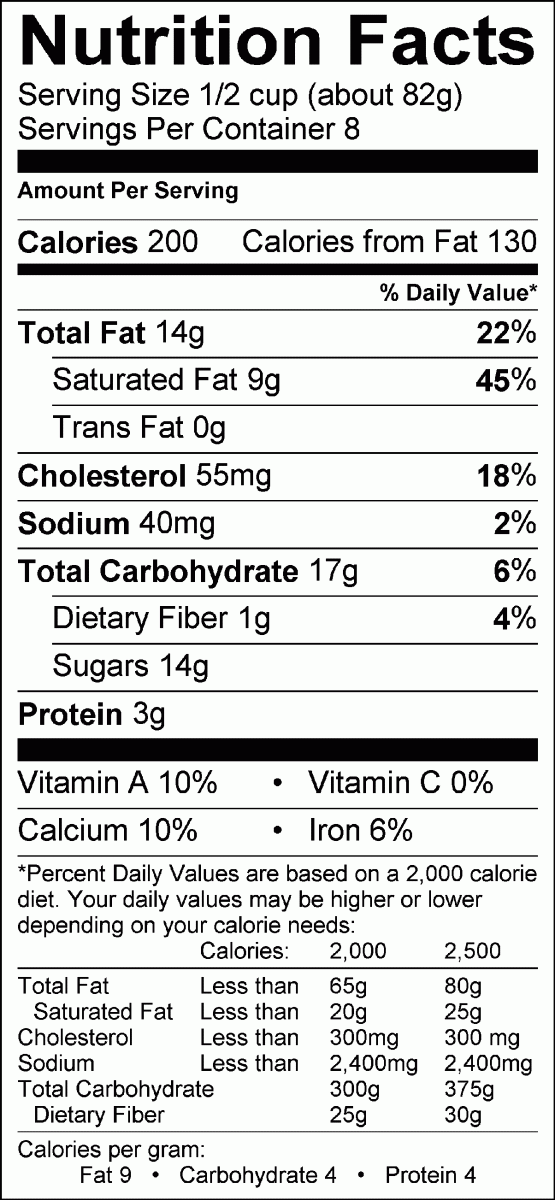There are 6 main things to look at on a nutrition label. Here is what you need to know about each:
Serving Size. Start here by checking the serving size. The label describes the nutritional value for the stated serving size, not the whole package. For example, if the label on a box of pasta says the serving size is 1 cup, but you usually eat 2 cups of pasta, you will need to double all of the nutrition information.
Calories. The average person should consume about 2000 calories per day, less if you’re not active. It sounds like a lot but consider your average McDonald’s Big Mac meal (Big Mac, medium fries and coke) has about 1130 calories. That is more than ½ of the calories you should consume for one day. Remember that the calories listed on the label will only be for the serving size, not the whole package. Spread out the calories you consume over the day.
Total Fat (including Saturated Fat & Trans Fat). Total fat tells you how much fat is in one serving of the product you are looking at. It includes healthy fats our bodies need (mono- and poly-unsaturated) and unhealthy fats we should limit (trans fats and saturated fats). Remember to limit the saturated fats and avoid ALL trans fats.
Sodium.
Sodium is salt. Adults should aim for less than 2300 mg of sodium per day; this includes table salt as well as salt already present in foods. If you have high blood pressure, diabetes or kidney disease; are over 50; or are of African-American descent, it is recommended to consume even less salt (1500 mg daily). Fresh foods are generally much lower in salt than packaged foods.
Total Carbohydrates (including sugar and fiber).
The total carbohydrates listed include sugars, dietary fibers, and other carbohydrates. Carbohydrates are a part of a healthy and balanced diet. However, some carbohydrates are better than others. Try to get the majority of your carbohydrates from fruits, vegetables, beans, and whole grain sources (whole grain cereals, breads, brown rice, quinoa, etc). Click here for information on how to find whole grains at the grocery store. Look for foods with more fiber, and less sugar.
Sugars, listed on nutrition labels, include both natural-occurring sugars and added sugars. Foods with only natural sugars — like fruit and milk — will show a number next to sugars on the Nutrition Facts Panel, but will not show any sugar-words in the ingredient list. Added sugars are found in many products, especially sodas, cookies and other special-occasion treats. Limit the added sugars, by referring to the ingredients list at the bottom of the food label. Names for added sugars on food labels include:
- Brown Sugar
- Invert Sugar
- Corn Sweetener
- Lactose
- Corn Syrup
- Maltose
- Dextrose Fructose
- Malt Syrup
- Fruit Juice Concentrates
- Molasses
- Glucose
- Raw Sugar
- High-fructose Corn Syrup
- Sucrose
- Honey
- Simple Sugar
Protein Helps build muscle. Foods like chicken, tofu, seafood, nuts and beans are high in protein.
Ingredients
As a rule of thumb, the fewer ingredients a product has, the healthier it is. Our bodies evolved for millions of years eating the bounty of nature, and that’s what suits them best. Ingredients are listed in descending order, from the greatest amount to the least. This means that foods with sugar as the first or second ingredient are high in sugar and low in other needed nutrients.
Buzz Words: Reduced Fat, Low Fat, and Light
Don’t let these words fool you into thinking that the product is automatically healthy. These words are often used on packaging to describe products that might be low in fat but not necessarily nutritious. A low fat food can also be high is sugar or high in calories, while offering little that’s good for you.



